A preliminary baseline status of the Syrian Brown Bear Ursus arctos syriacus (Mammalia: Carnivora: Ursidae) in Golestanak, Northern Iran
Mohammad Sadegh Farhadinia 1 & Negin Valizadegan 2
1 Iranian Cheetah Society, PO Box 14155-8549, Tehran, Iran
2 Department of Environmental Science, Gorgan University of Agricultural Sciences and Natural Resources,
Gorgan, Iran
1 msfarhadinia@wildlife.ir (corresponding author), 2 negin_valizaegan@yahoo.com
Abstract: Baseline information is lacking for the Syrian Brown Bear across the sub-species range, making it difficult to assess at any level. In the present investigation, our goal was to illustrate the population status of the Brown Bear in the Golestanak area, northern Iran, based on field surveys we conducted during the summers of 2011 and 2012. We counted a total of 30 and 21 bears in two consecutive years, with family groups consisting of more than half of the identified individuals. Sub-adults had the lowest contribution among the observed individuals, just below 10%, which may be due to their high dispersal behaviour to avoid adults. Our results provide a foundation for future systematic baseline investigations on the population status of the brown bear in northern Iran, which can be used in management programs. Aside from improving monitoring efforts within key habitats of the species, enhancing conservation efforts to secure the population is essential to safeguard this female core area.
Keywords: baseline assessment, Brown Bear, Iran, monitoring, Ursus arctos syriacus.
doi: http://dx.doi.org/10.11609/JoTT.o3708.6796-9 | ZooBank: urn:lsid:zoobank.org:pub:FCE72B76-795E-4F60-BF48-E18978DDC380
Editor: Diana Doan-Crider, Texas A&M University, Texas, USA. Date of publication: 26 January 2015 (online & print)
Manuscript details: Ms # o3708 | Received 14 July 2013 | Final received 29 December 2014 | Finally accepted 02 January 2015
Citation: Farhadinia, M.S. & N. Valizadegan (2015). A preliminary baseline status of the Syrian Brown Bear Ursus arctos syriacus (Mammalia: Carnivora: Ursidae) in Golestanak, northern Iran. Journal of Threatened Taxa 7(1): 6796–6799; http://dx.doi.org/10.11609/JoTT.o3708.6796-9
Copyright: © Farhadinia & Valizadegan 2015. Creative Commons Attribution 4.0 International License. JoTT allows unrestricted use of this article in any medium, reproduction and distribution by providing adequate credit to the authors and the source of publication.
Funding: The major funding for this research came from Dutch Zoo Conservation Fund (DZCF) and Iranian Cheetah Society (ICS) while other supports (e.g., logistic) came from Mazandaran Provincial Office of Iran Department of Environment.
Competing Interest: The authors declare no competing interests.
Acknowledgements: We thank the Iranian Department of the Environment and its provincial office in Mazandaran for granting necessary permissions to conduct the surveys. The Dutch Zoo Conservation Fund (DZCF) partially funded the project. Finally, we feel privileged to express our respect to the wardens for their kindly cooperation in field surveys, particularly Y. Sinakaei, R. Eshaghi, and O. Sheykholeslam. Also, we are grateful to Fathollah Amiri, Ali Zolfaghari, Amir Ghashghaie, Arash Moharrami, Nima Asgari and Bagher Nezami for accompanying us in field surveys.

Small populations of Brown Bears Ursus arctos are scattered across the Middle East and in the Caucasus Mountains, which are noted to belong to a different subspecies. Ursus arctos arctos (Murtskhvaladze et al. 2010) is found in the Greater and Lesser Caucasus, and the Syrian Brown Bear Ursus arctos syriacus (Calvignac et al. 2009), still occurs in Iran, Iraq and Turkey (Boitani et al. 2008). While little is known about the status of these bear populations (Gutleb et al. 2002; Can & Togan 2004; Lortkipanidze 2010), the region’s bear populations have been prioritized for assessment by the IUCN/SSC Bear Specialist Group (Servheen et al. 1999).
As the largest carnivore in Iran, the Syrian Brown Bear is exclusively distributed across the northern and western portions of the country, along the two mountain ranges of Alborz and Zagros (Gutleb & Ziaie 1999). At the national level, the lack of population data has led to a wide range of estimates (500–1000, Gutleb & Ziaie 1999; 1500±300, Gutleb et al. 2002), making it difficult to assess their status at regional or national levels. Baseline information is essential for understanding their status, which can only be obtained through monitoring programs that ensure the adequate conservation and management of the species (Kindberg et al. 2009).
We conducted the present investigation within one of the main breeding areas, or core zones, of the Brown Bear in the central Alborz region (Nezami & Farhadinia 2011), to determine the status and structure of the Brown Bear population based on direct observations. The goal of this study was to conduct a preliminary assessment on the population status of the brown bear in the Golestanak, which will establish a baseline for future monitoring.
Methods
Study area: We conducted this study in Golestanak, which is located in the Central Alborz protected area in northern Iran (Fig. 1, Image 1). With an area of almost 50km2, it consists of Hyrcanian forests and highland timberline scrublands (Darvishsefat 2006).
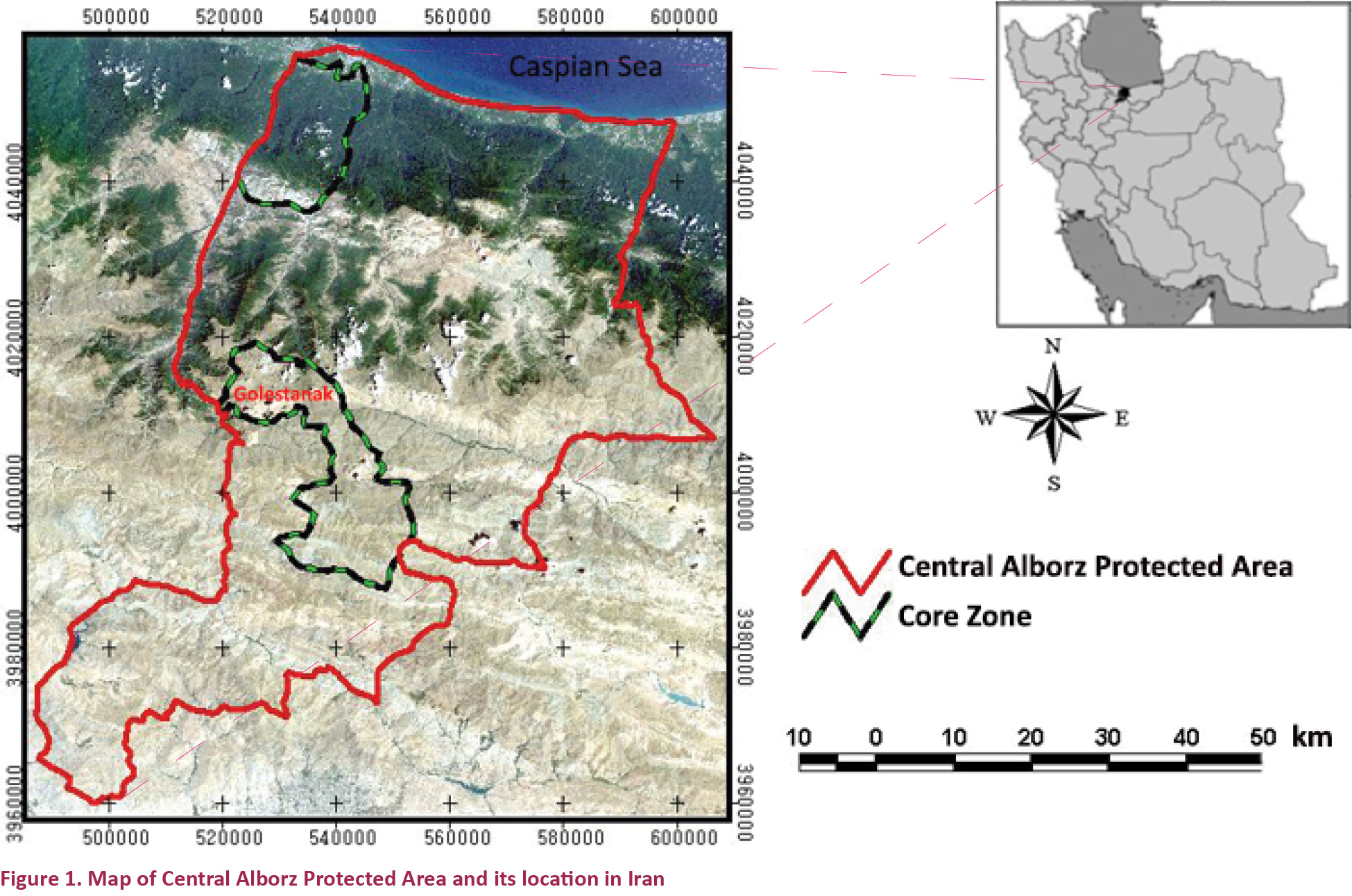
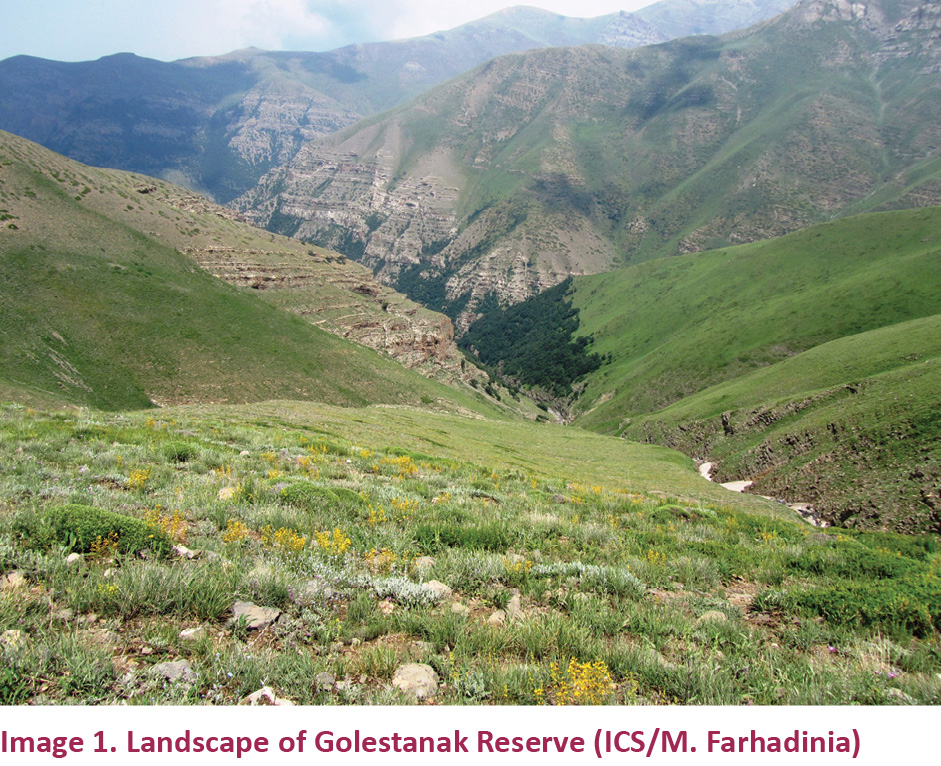
A high diversity of mammalian fauna including Persian Ibex Capra aegagrus, Red Deer Cervus elaphus maral, Roe Deer Capreolus capreolus, and Wild Boar Sus scrofa as well as Brown Bear, Grey Wolf Canis lupus, Eurasian Lynx Lynx lynx, and Persian Leopard Panthera pardus saxicolor inhabit this area (Nezami & Farhadinia 2010).
Field surveys: We carried out field investigations in 2011 and 2012 in Golestanak during June and July, when bears are more detectable in alpine meadows above the timberline. We conducted similar field efforts (that lasted eight days) at the same study site for two years. We searched the area using 12×42 binoculars (™Nikon Monarch). Upon sighting individuals, bears were approached sufficiently to make observations without disturbing the animal.
Identification of a bear’s sex was determined by the presence of cubs for females, or strikingly large body size for males. We recorded other individuals as unknown sex. As for age an animal was classified either as an adult, sub-adult (younger than four years) and cub (with the mother). We also recorded colour and body morphological patterns of bears (Sellers & Aumiller 1994; Nawaz 2008), which we felt might be useful for future observations. When possible, we also followed bears at a safe distance to record their behaviour. In order to obtain a more accurate identification of different individuals and to avoid double counting, we photographed or filmed most bears using cameras equipped with zoom lenses (50–500 Sigma). Digitized photographic data were stored in a database, and used to help with the analysis of bear numbers. Due to colour variation of the bears in different years (Nawaz 2008), we avoided comparison between years.
Results
In 2011, we identified 30 different bear, but we were not able to determine sex for most of the individuals. Cubs (n=10) comprised 33% of the population, in contrast to adults (n=16), which comprised more than half of the sighted individuals. We recognized and recorded five adult females with cubs (one female had three cubs) (Table 1) (Image 2).
In 2012, we recorded 21 different individuals, including five families. Nine cubs with their mothers consisted of 43% of the whole identified population. Except one (Image 3), other bears were adults (Table 1).
An average of 56.8% of bears seen during the two year period were family groups (mothers with cubs). Adults of both sexes composed 53% of the population observed during the survey period. The proportion of sub-adults in Golestanak averaged 9.8%. During the study period, we observed four occasions when female bears avoided other bears (three adult males and one young bear) as well as one female trying to stop an adult male chasing her cubs (Image 4).
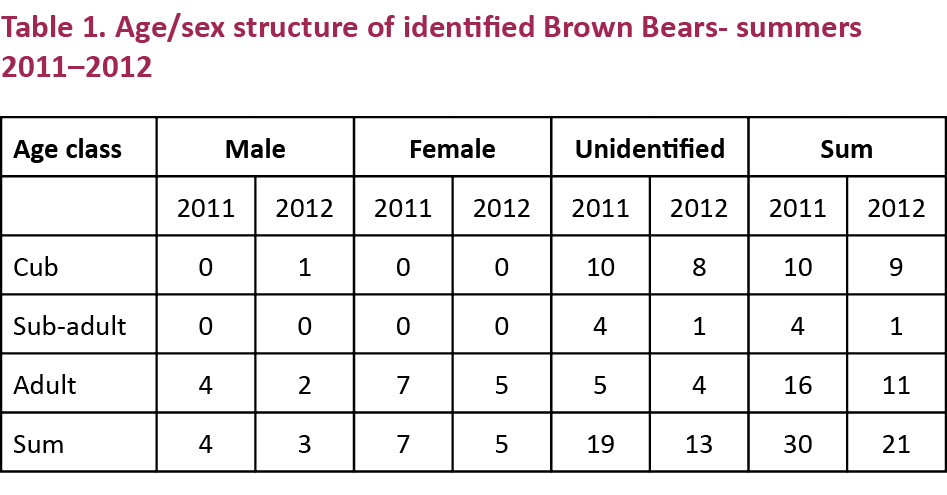
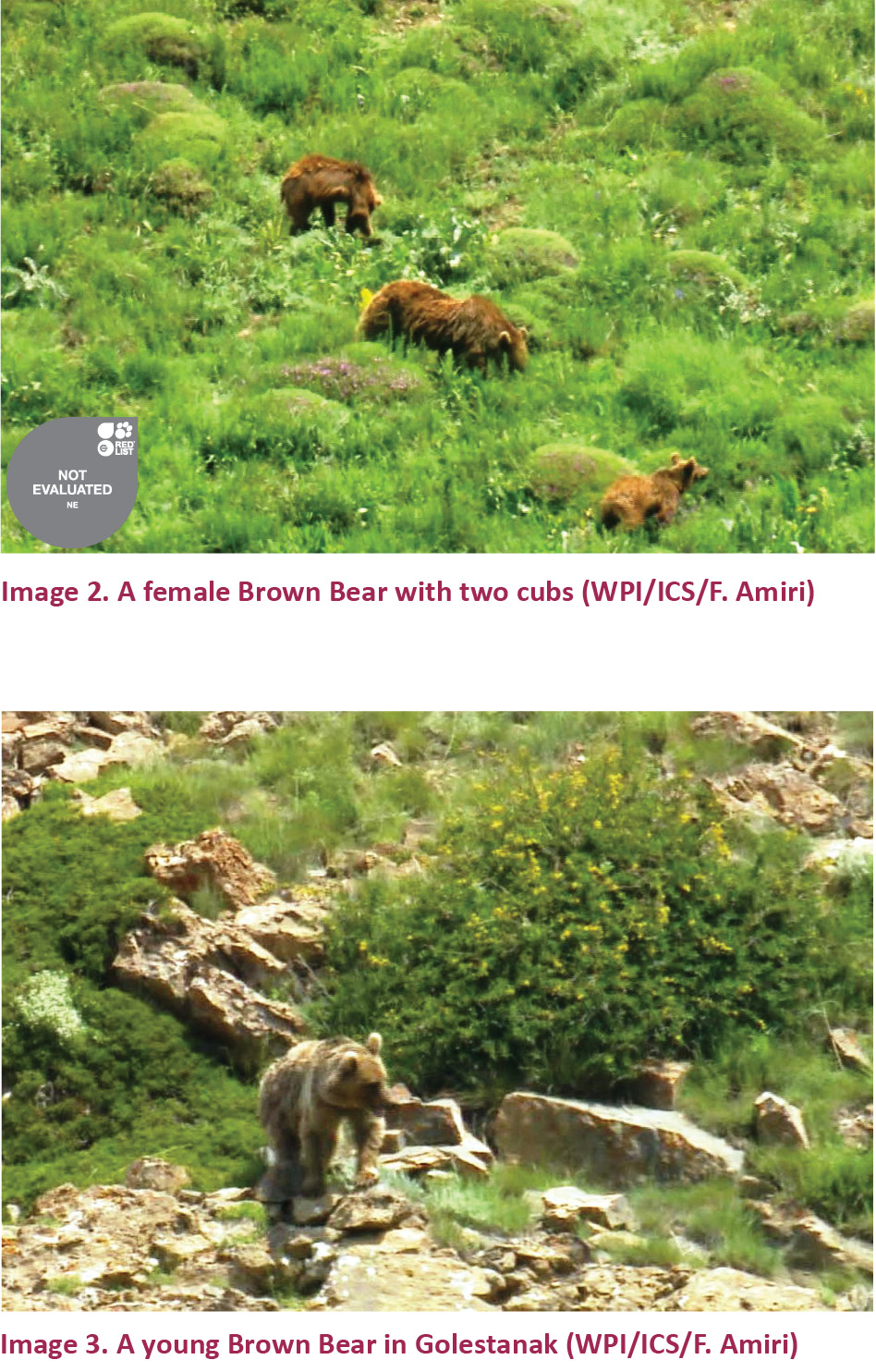
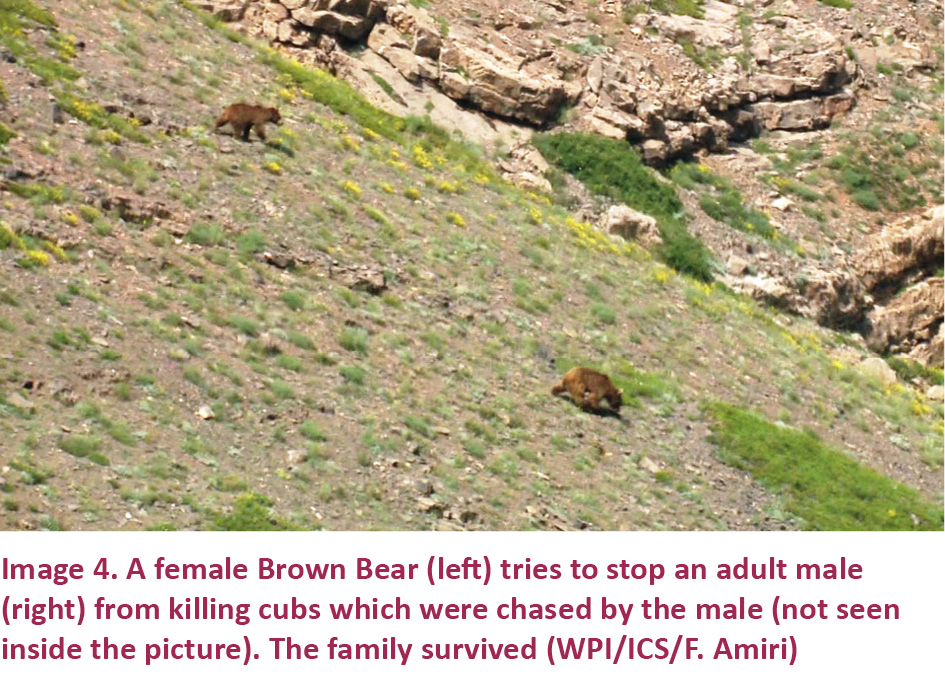
Discussion
In this study, we attempted to provide some basic information on the status of the Syrian Brown Bear population in northern Iran, which is known as a key area for the bears in Iran (De Filippi 1862 cited in Lay 1967; Blanford 1876; Goodwin 1940; Misonne 1959; Lay 1967; Gutleb & Ziaie 1999). However, we were unable to provide an estimate of the species’ population in the area, because our sampling efforts were limited. In addition, previous studies indicate that direct observation may result in an underestimation of population size (Schwartz et al. 2008; Kendall et al. 2009).
A female core area is defined as the area where reproduction is documented annually (Swenson et al. 1994). The Golestanak has a high breeding potential (Nezami & Farhadinia 2011), which is part of a vast range of the species in Central Alborz (Nezami & Farhadinia 2010; Ataei et al. 2012).
The ratio of cubs was 1/3rd of the observed population in this study in Golesnatak, which is approximately two times the ratio in a studied population in Pakistan (Nawaz 2008). The average numbers of recorded cubs in 10 families in this study were close to the average numbers recorded based on 13 families that were observed between 2005 and 2009, which was 2.00±0.2) (Nezami & Farhadinia 2011).
In conclusion, we recommend the implementation of more comprehensive surveys in this area to determine the demographic parameters of this bear population. Our data establish a baseline for further monitoring efforts, preferably by application of robust methods such as capture-recapture models using extracted DNA from fecal samples (Bellemain et al. 2005; Gervasi et al. 2010). Nevertheless, in areas with high bear visibility such as Golestanak, direct observations are useful to monitor trends in the population (Kindberg et al. 2011), especially in regions with low human impact (Sellers & Aumiller 1994). Given the reproductive importance of the area, its continued protection should be a priority.
References
Ataei, F., M. Karami & M. Kaboli (2012). Summer habitat suitability modelling of Brown Bear (Ursus arctos) southern Alborz Protected Area. Iranian Journal of Natural Resources 65(2): 235–245. [article in Persian with an abstract in English]
Bellemain, E., J.E. Swenson, D. Tallmon, S. Brunberg & P. Taberlet (2005). Estimating population size of elusive animals using DNA from hunter-collected feces: comparing 4 methods for Brown Bears. Conservation Biology 19: 150–161.
Blanford, W.T. (1876). Eastern Persia. An Account of the Journeys of the Persian Boundary Commision, 1870–1872, Vol. 2. The Zoology and Geology. Macmillan and Co., London, viii+516 pp.
Boitani, L., R.M. Cowling, H.T. Dublin, G.M. Mace, J. Parrish, H.P. Possingham, R.L. Pressey, C. Rondinini & K.A. Wilson (2008). Change the IUCN Protected Area Categories to Reflect Biodiversity Outcomes. PLoS Biology 6(3): 436–438; http://dx.doi.org/10.1371/journal.pbio.0060066
Calvignac, S., S. Hughes & C. Hanni (2009). Genetic diversity of endangered Brown Bear (Ursus arctos) populations at the crossroads of Europe, Asia and Africa. Diversity and Distributions 15: 742–750.
Can, O. & I. Togan (2004). Status and management of brown bears in Turkey. Ursus 15: 48–53.
Darvishsefat, A.A. (2006). Atlas of Protected Areas of Iran. 1st edition. Tehran, Iran: University of Tehran, 157pp.
De Filippi, F. (1862 (cited in Lay DM )1967). A study of the mammals of Iran, Fieldiana Zoology, Vol. 54, Field Museum of Natural History, Chicago, 220pp.
Gervasi, V., P, Ciucci, F. Davoli, J. Boulanger, L. Boitani & E. Randi (2010). Addressing challenges in non-invasive capture-recapture based estimates of small populations: a pilot study on the Apennine brown bear. Conservation Genetics 11: 2299–2310.
Gutleb, B., R.A. Ghaemi & J. Kusak (2002). Brown Bear in Iran. International Bear News 11(4): 20.
Gutleb, B. & H. Ziaie (1999). On the distribution and status of the Brown Bear, Ursus arctos, and the Asiatic Black Bear (U. thibetanus) in Iran. Zoology in the Middle East 18(1): 5–8.
Goodwin, G.G. (1940). Mammals collected by the Legendre 1938 Iran Expedition, American Museum Novitates 1082: 1–17
Kendall, K.C., J.B. Stetz, J. Boulanger, A.C. Macleod, D. Paetkau & G.C. White (2009). Demography and genetic structure of a recovering grizzly bear population. Journal of Wildlife Management 73: 3–17.
Kindberg, J., G. Ericsson & J.E. Swenson (2009). Monitoring rare or elusive large mammals using effort-corrected voluntary observers. Biological Conservation 142: 159–165.
Kindberg J, J.E. Swenson, G. Ericsson, E. Bellemain, C. Miquel & P. Taberlet (2011). Estimating population size and trends of the Swedish Brown Bear (Ursus arctos) population. Wildlife Biology 20(5): 279–284; http://dx.doi.org/10.2981/wlb.00042
Lay, D. (1967). A study of the mammals of Iran, Fieldiana Zoology 54. Chicago: Field Museum of Natural History, 282pp.
Lortkipanidze, B. (2010). Brown Bear distribution and status in the South Caucasus. Ursus 21(1): 97–103.
Misonne, X. (1959). Analyse zoogeographique des Mammiferes de lran. Institut Royal des sciences naturelles de Belgique 59(2): 1–157.
Murtskhvaladze, M., A. Gavashelishvili, & D. Tarkhnishvili (2010). Geographic and genetic boundaries of Brown Bear (Ursus arctos) population in the Caucasus. Molecular Ecology 19: 1829–1841.
Nezami, B, & M.S. Farhadinia (2010). Report of the conservation of Brown Bear Ursus arctos in Golestanak Reserve, Iran. Dutch Zoo Conservation Fund, Netherlands.
Nezami, B., & M.S. Farhadinia (2011). Litter sizes of Brown Bears in the Central Alborz Protected Area, Iran. Ursus 22(2): 167–171.
Nawaz, M.A. (2008). Ecology, Genetics and Conservation of Himalayan Brown Bears. PhD Thesis. Department of Ecology and Natural Resource Management, Norwegian University of Life Sciences, 224pp.
Schwartz, C.C., M.A. Haroldson, S. Cherry & K.A. Keating (2008). Evaluation of rules to distinguish unique female Grizzly Bears with cubs in Yellowsttone. Journal of Wildlife Management 72: 543–554.
Sellers, R.A. & L.D. Aumiller (1994). Brown Bear population characteristics at McNeil River, Alaska. International Conference on Bear Research and Management 9(1): 283–293.
Servheen, C., S. Herrero & B. Peyton (eds.) (1999). Status Survey of the Bears of the World and Global Conservation Action Plan. IUCN, Gland, Switzerland.
Swenson, J.E., F. Sandegren, A. Bjarvall, A. Soderberg, P. Wabakken & R. Franzen (1994). Size, trend, distribution and conservation of the Brown Bear Ursus arctos population in Sweden. Biological Conservation 70: 9–17.
6799